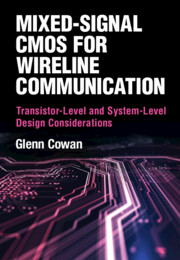 Mixed-Signal CMOS for Wireline Communication
Mixed-Signal CMOS for Wireline Communication Published online by Cambridge University Press: 05 December 2024
Electrical-link design is challenging due to the frequency-dependent loss and reflections associated with electrical channels as well as cross-talk between nearby channels. The equations describing lossless and lossy transmission lines are introduced in this chapter, followed by a brief discussion of loss mechanisms. The characteristics of various channels are presented, along with the effect of wirebonds and packages. The goal of this chapter is to provide link designers with a methodology to estimate the overall pulse response of a channel consisting of a lossy transmission line and the relevant package and chip parasitic elements. Knowing the pulse response, a link designer can then contemplate and model the equalization (discussed in Chapter 4) needed to properly detect transmitted bits. This chapter is organized to discuss transmission-line fundamentals and then overall channels.
To save this book to your Kindle, first ensure [email protected] is added to your Approved Personal Document E-mail List under your Personal Document Settings on the Manage Your Content and Devices page of your Amazon account. Then enter the ‘name’ part of your Kindle email address below. Find out more about saving to your Kindle.
Note you can select to save to either the @free.kindle.com or @kindle.com variations. ‘@free.kindle.com’ emails are free but can only be saved to your device when it is connected to wi-fi. ‘@kindle.com’ emails can be delivered even when you are not connected to wi-fi, but note that service fees apply.
Find out more about the Kindle Personal Document Service.
To save content items to your account, please confirm that you agree to abide by our usage policies. If this is the first time you use this feature, you will be asked to authorise Cambridge Core to connect with your account. Find out more about saving content to Dropbox.
To save content items to your account, please confirm that you agree to abide by our usage policies. If this is the first time you use this feature, you will be asked to authorise Cambridge Core to connect with your account. Find out more about saving content to Google Drive.